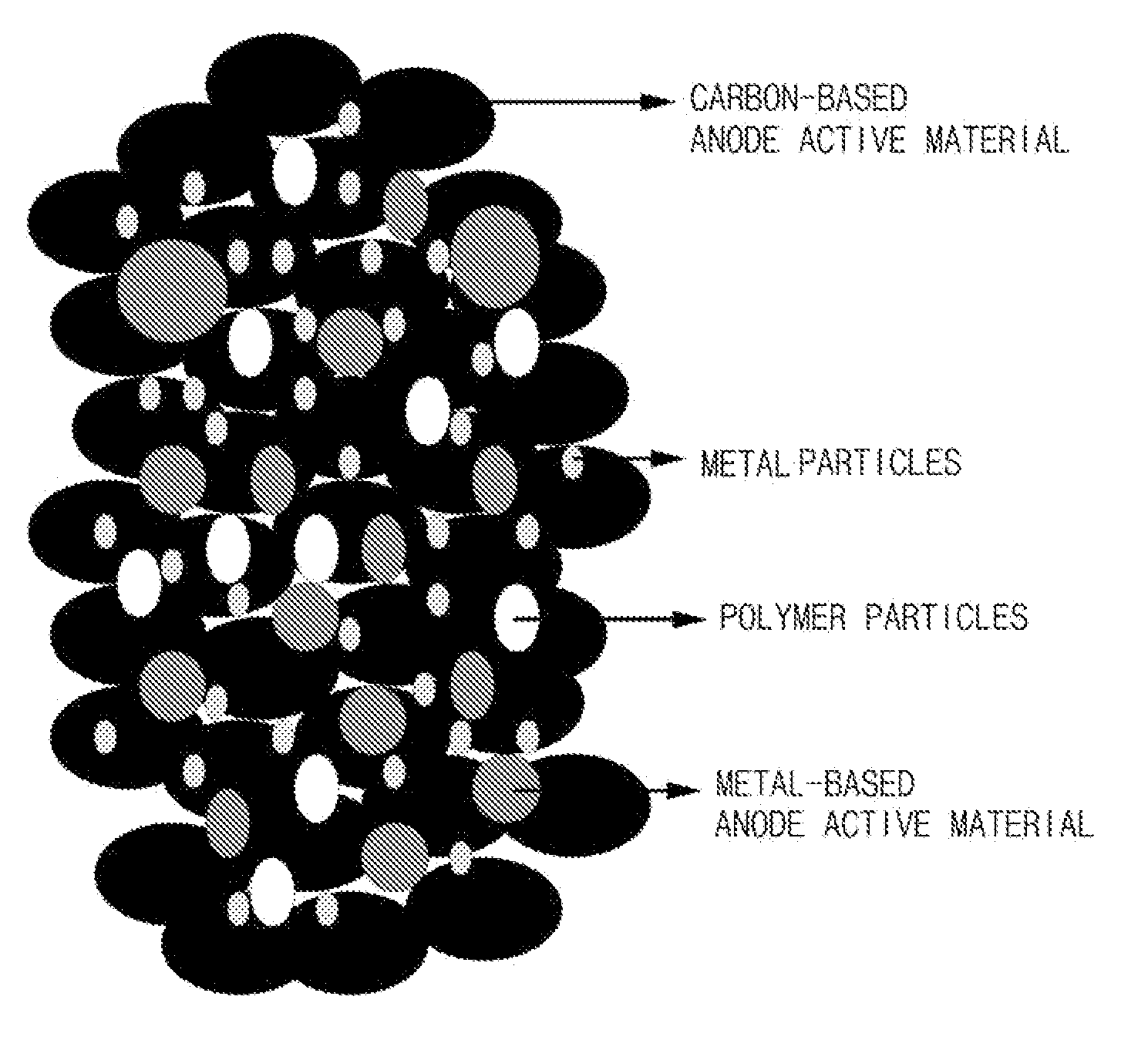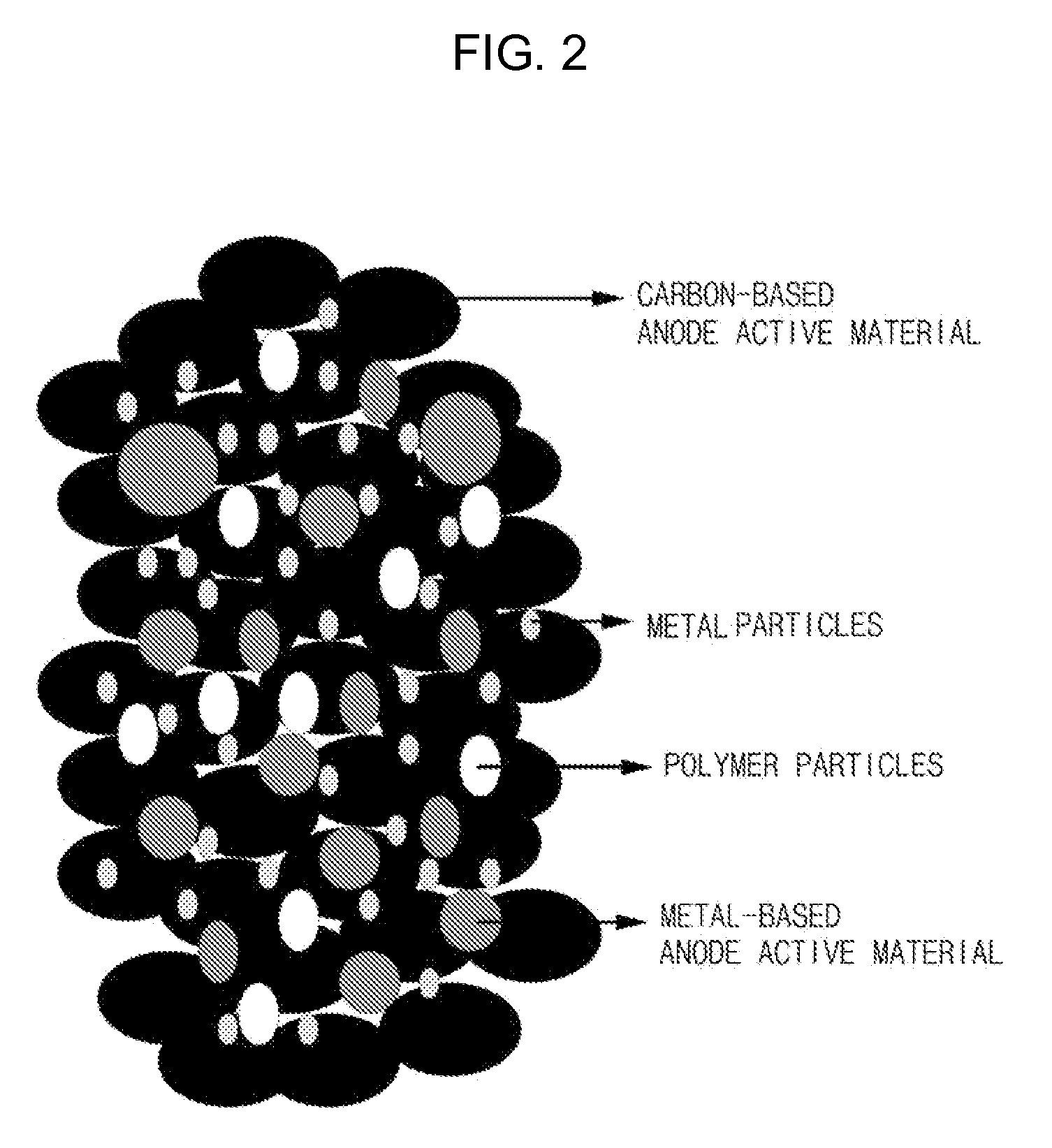Composite anode active material, anode including the same and lithium battery using the anode
a lithium battery and active material technology, applied in the direction of non-aqueous electrolyte accumulator electrodes, sustainable manufacturing/processing, climate sustainability, etc., can solve the problems of short cycle life performance, unsuitable anode active material for lithium batteries, and risk of explosion, so as to improve initial efficiency and cycle life performance, the effect of large capacity
- Summary
- Abstract
- Description
- Claims
- Application Information
AI Technical Summary
Benefits of technology
Problems solved by technology
Method used
Image
Examples
example 1
[0061]18.2 g of a graphite-based anode active material, 10 g of a Si-based active material and 1.8 g of polymer particles composed of a polystyrene crosslinked polymer having an average particle diameter of 4 μm were mixed using a high energy ball milling machine to prepare a composite active material.
[0062]15 g of the composite active material, 2 g of graphite and 2 g of a conducting agent (graphite-based conducting agent prepared by Timcal, SFG6) were mixed, and then 1 wt % of an aqueous carboxylmethyl cellulose sodium salt solution (60 g) was added to the mixture and mixed. 20 wt % of a water dispersion polyacrylate binder (2 g) was added to the resultant and fully mixed to prepare a slurry. The slurry was coated onto a copper (Cu) current collector with a thickness of 15 μm using a doctor blade to a thickness of about 75 μm. The manufactured electrode was dried for two hours in a heat flow type dryer at a temperature of about 100° C. Then, the dried electrode was further dried i...
example 2
[0063]16.85 g of a graphite-based anode active material, 10 g of a Si metal-based active material and 3.15 g of polymer particles composed of a 1.46 g of Ni coated polystyrene crosslinked polymer having an average particle diameter of 4 μm were mixed using a high energy ball milling machine to prepare a composite active material.
[0064]An anode was manufactured in the same manner as in Example 1, except that the composite active material obtained as above was used.
example 3
[0065]15.5 g of a graphite-based anode active material, 10 g of a Si metal-based active material and 4.5 g of polymer particles composed of a polystyrene crosslinked polymer having an average particle diameter of 4 μm, wherein the polystyrene crosslinked polymer comprising a first layer including 1.44 g of Ni and a second layer including 1.395 g of Au, were mixed using a high energy ball milling machine to prepare a composite active material.
[0066]An anode was manufactured in the same manner as in Example 1, except that the composite active material obtained as above was used.
PUM
| Property | Measurement | Unit |
|---|---|---|
| diameter | aaaaa | aaaaa |
| diameter | aaaaa | aaaaa |
| diameter | aaaaa | aaaaa |
Abstract
Description
Claims
Application Information
 Login to View More
Login to View More - R&D
- Intellectual Property
- Life Sciences
- Materials
- Tech Scout
- Unparalleled Data Quality
- Higher Quality Content
- 60% Fewer Hallucinations
Browse by: Latest US Patents, China's latest patents, Technical Efficacy Thesaurus, Application Domain, Technology Topic, Popular Technical Reports.
© 2025 PatSnap. All rights reserved.Legal|Privacy policy|Modern Slavery Act Transparency Statement|Sitemap|About US| Contact US: help@patsnap.com



